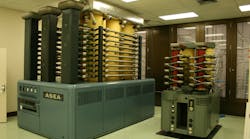Since this month’s feature column was about the Vancouver HVDC Intertie, I thought it might be appropriate to provide a little background on the history of the mercury-arc valve. This device made HVDC a viable technology. Of all the switching technologies being investigated by early DC advocates, mercury-arc rectification was found to be the most suitable device for handling large currents. The mercury-arc rectifier was invented by Peter Cooper Hewitt around 1902 and began a refinement process that extended into the 1950s. About 1930, control grids were added to the mercury-arc valve with pool cathodes. These grids were used to control the conduction progression required for regulating the starting process.
That was followed by the addition of the atmospheric arc converter designed by E. Marx in 1932. It was a device that used an arc ignited by a high-frequency spark between auxiliary electrodes in the path of the main arc between like water cooled main electrodes. The arc was extinguished after current zero by a blast of air on the arc path, which allow the device to handle power up to 40 MW, but only for a short time. By the mid-1930s experimentation on HVDC systems was in full swing. GE built an experimental 17-mile (27 km) HVDC system between a New York Power & Light hydroelectric plant in Mechanicville, NY and the GE factory in Schenectady, NY. The was rated 5.25 MW at 30-kV and the converters at each end used 12 “hot-cathode” glass envelope thyratrons in 6 series pairs. The AC input was 40-Hz and the output was 60-Hz, which demonstrated an important feature of DC transmission – frequency conversion.
The most successful improvement in the mercury-arc valve development for high voltage applications took place in Sweden in 1939 by Dr. Uno Lamm working for ASEA. Dr. Lamm invented a system of grading electrodes with a single-phase valve construction, which was the basis for larger peak inverse withstand voltages (i.e., maximum voltage the valve can block). This caused the valve to operate as a rectifier. After the war, Dr. Lamm’s mercury-arc efforts resulted in the first commercial HVDC link between the island of Gotland and the Swedish mainland, which was commissioned in 1954. It could transfer 20-MW at 100-kV over a 60-mile (98 km) submarine cable built by ASEA.
The Gotland scheme became a test bed for many HVDC innovations and in 1970 became the first application of the new thyristor valve technology. The original mercury-arc valves were operated alongside the new thyristor valve technology, becoming the first hybrid HVDC scheme, but the advent of the thyristor marked the end of the mercury-arc valve HVDC converter scheme. There are many texts available with more detail of the pioneering work between 1902 and 1954 if you are interested in reading more about the mercury-arc valve.


